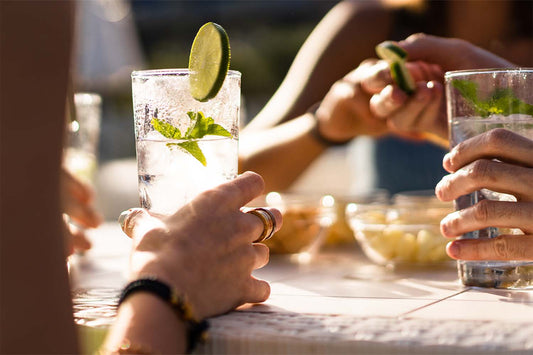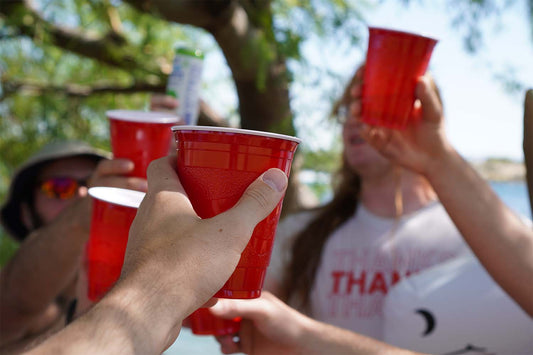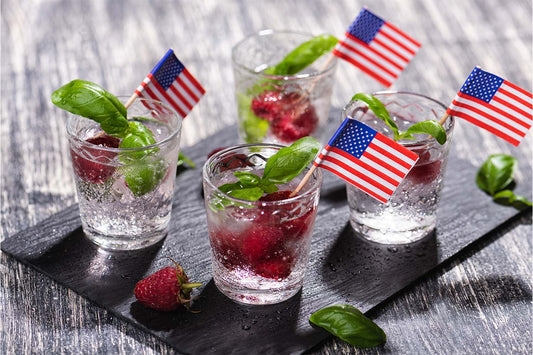Campari and Aperol are often spoken of together, which makes many people think they’re the same thing. But they’re not.
Campari and Aperol are the two original brands of the Italian bitter apéritif style. They’re very similar in taste, so they often get mixed up. This has created the Campari vs. Aperol feud.
These two sibling brands are becoming more well known because they’re popular as ingredients in mixed drinks. The aperitivi-style Italian bittersweet liquor is also rising in popularity, causing people to look beyond these two brands.
The average person may not know about Campari and Aperol and what separates the two. Interestingly enough, these brands have become an insert for this style of alcohol, like how the name Q-tips tends to encompass all cotton swabs.
Not sure where to start? We’ve got you covered!
What Is an Apéritif?
You’ll keep hearing about how both of these liquors are apéritifs and may be thinking, “What is an Apéritif?”
It’s a drink that’s served before a meal. The idea is that this style of drink stimulates your appetite and makes you enjoy your meal even more. It’s important to know that you don’t have to have these drinks only before a meal.
Apéritifs tend to be dry, bitter, and have low alcohol content. The low alcohol content is important because your sense of taste can dull when drinking too much alcohol.
If you’re nervous about a big meal you’ve made, serve some apéritif-styled drinks, and your food will seem even more delicious.
It doesn’t count as cheating; it’s using smart culinary strategies.
What Is Campari?
Campari was created in Italy in 1860 by a man named Gaspare Campari. Yes, he did name the drink after himself. Later, he would have an entire alcohol company in his name.
Its signature bright red color originally came from crushed insects. Thankfully, that’s not the case nowadays, so you don’t have to worry about bugs in your glass. They started using artificial coloring in 2006.
Campari is a very mysterious drink. The recipe is only known by one person, the factory manager. Experts think one of the dominant flavors comes from chinotto fruit. Experts also believe there are between 20 to 80 ingredients, but no one knows for sure.
Pinning down the flavors in Campari can be hard since everyone's sense of taste is different. Some flavors that are mentioned with this spirit are
- Bitter
- Cherry
- Clove
- Cinnamon
- Orange
- Rhubarb
- Berries
- Various herbs
According to Gruppo Campari, Campari’s manufacturer, it’s most popular in Italy, Argentina, the United States, Germany, and Brazil.
Campari, when unopened, has an indefinite shelf life. Once opened, you should drink it within a year. Make sure to keep the original cap to seal it and keep it in a cool spot out of direct sunlight.
What Is Aperol?
Shockingly, Aperol was also created in Italy! It was created in 1919 by Luigi and Silvio Barbieri. Yes, they’re brothers.
In 2003, Campari Group bought the brand Aperol and is now under the same group. Just like Campari, its recipe is also shrouded in mystery.
The Aperol site describes the spirit as lightly alcoholic with complex herbs and a bit of orange and vanilla. It has woody and herbal body notes and is bittersweet and just a little salty.
Aperol can taste like
- Bitter
- Orange
- Gentian flower
- Cinchona flowers
- Rhubarb
- Various herbs
It’s most popular in Italy, Germany, and Austria.
Aperol has to be refrigerated due to its lower alcohol volume, which makes it more susceptible to spoiling. However, if it’s sealed with the original top and properly refrigerated, it can last a very long time.
Campari vs. Aperol: What's the Difference?
Many people often call these two spirits siblings because they’re so similar. However, there are some key differences.
The Difference Between the Two
As already mentioned, they were invented by different people at different times.
Campari tends to be thought of as the older sibling because of its darker color and higher alcohol content. Campari is a deep red and is 20.5 to 28.5 percent alcohol by volume (ABV), depending on where it’s sold, which is twice that of Aperol.
Aperol is the younger sibling because it has a bright orange color and is generally more approachable than Campari. Aperol is sweeter than Campari and has around 11 percent ABV level.
The biggest difference may be how they’re used. Aperol is used to complement other flavors in cocktails and mixed drinks because it doesn’t have a high alcohol level.
Campari has a higher alcohol content and more flavor. Therefore it tends to dominate other flavors in cocktails.
What’s the Same?
Both Campari and Aperol are Italian bitters, and they’re served before a meal. Both were created by men who wanted to experiment with flavors and offer something new to drink.
They’re brightly colored and share similar flavors with citrus and herbs. Together they both make incredibly popular mixed drinks that people love. They can work for people who have a sweet tooth, people who prefer bitter drinks, and those who have different preferences for how much alcohol is in their drink.
Are There Alternatives to These Aperitivi?
Yes, luckily, there are some substitutions for Campari and Aperol. Why might you need a substitution?
Well, maybe there’s something about the taste you aren’t a fan of. Maybe you don’t like the fact you don’t know all the ingredients, which is fair. Depending on what kind of diet you have, it may be important to know every ingredient in the substances you eat or drink. “Big alcohol,” as we like to call it, sometimes throws some very sketchy additives into their concoctions, and they’re not even required to tell you about them.
On a more practical note, maybe you just ran out of Campari or Aperol and didn’t want to have to go out and buy more. There’s nothing worse than changing into more comfortable clothing, going to grab a drink, and then realizing you don’t have what you need.
Lucky for us, some alternatives taste just as great (or better, actually)—and best of all, you’ll know exactly what’s in them.
5 Alternatives to Campari and Aperol
1. Citrus Flower
This is a Californian take on the classic apèritif. It still shares the same citrus and herbal tastes as classic Aperol and Campari do. You can drink this on its own or mix it into a cocktail—especially one with club soda or prosecco.
Citrus Flower features lemons, orange peels, elderflower, Saigon cinnamon, and other botanical ingredients. You’ll especially taste the lemon, orange peels, and elderflower. It has an ABV of 18 percent, making it just under Campari alcohol level-wise.
2. Lemon Lavender
This apèritif focuses more on herbal tastes instead of citrus. It’s more soothing and refreshing versus bitter. It has a clean taste that’s great for the summer (or all year round).
Lemon Lavender features lemon peels, lavender, chamomile, coriander, bay leaf, and other herbs. The flavor highlights are lemon, lavender, and chamomile. It has 18 percent ABV, so slightly less alcoholic than Campari.
3. Grapefruit Jalapeno
Featuring whole grapefruit and jalapenos, this apèritif is bright and will wake up all of your senses. While tangy and spicy, it’s still light enough to enjoy multiple glasses.
Grapefruit Jalapeno also has makrut lime leaves, pink peppercorn, and dried Morita chili pepper. The most highlighted features are, of course, grapefruit and jalapeno. It has an ABV of 18 percent.
4. Pomegranate Rosemary
This apèritif may be the closest replacement for Aperol on this list. It’s light and full of citrus and herbal flavors. It is more alcoholic than Aperol at an ABV of 18 percent.
Pomegranate Rosemary works on its own and in mixed drinks. It features pomegranate, raspberry, orange peel, wild juniper berries, and rosemary.
5. New Fashioned
Warm and inviting, this apèritif is perfect for cold nights. It’s spicy yet smooth, thanks to ingredients like cinnamon and citrus.
New Fashioned features clove, gentian root, ginger, cinnamon, cinchona bark, and orange peels. It has an ABV of 18 percent.
The Campari vs. Aperol Debate Has Been Settled
Well, hopefully, it’s been settled for you.
The biggest difference between the two is the level of bitterness and alcohol each brand has. So whether one is better than the other is up to personal preference. Depending on how much of a buzz you’d like to get, one may be better than the other.
Remember, hangovers the next day are no fun at all.
They’re both favored for creating mixed drinks, both have citrus and herbal tastes, and both are often served before a delicious meal. The sibling metaphor truly suits these two brands—but we’re a little tired of this duo and are looking to try something new.
If you’re not sure where to start, we have a great sample kit that features 4 of our apèritifs of your choosing.
Sources:
Apéritif Definition and Cocktail Recipes | The Spruce Eats
The Why and How Of Serving An Aperitif | Everyday Health




